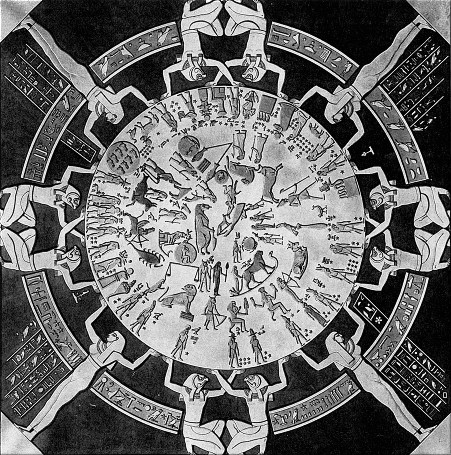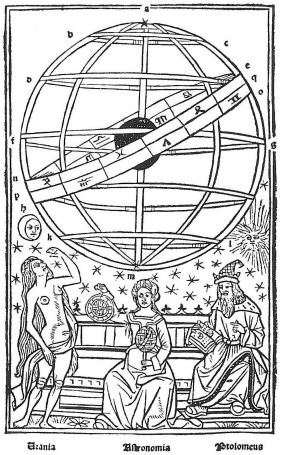
Development of astronomy from the ancient times to the fifteenth century
From ancient times until the Renaissance astronomy was orientated on
the most accurate description of motions of celestial bodies observed with
the naked eye: stars, and mainly planets including the Sun and the Moon.
 The Earth occupied a special position in the universe. In ancient times
astronomy could be divided into two branches: a practical one, which was
connected to the needs of everyday life; and a scientific one, which was
focused on the formation of mathematical models, with the use of which
planetary motions on the celestial sphere could be described accurately
and their future location predicted. The first trend prevailed in the cultures
of Egypt and Mesopotamia, the second one reached its climax in Greece and
had a decisive influence in the way mathematical astronomy was practised
in Latin Europe until the times of Copernicus.
The Earth occupied a special position in the universe. In ancient times
astronomy could be divided into two branches: a practical one, which was
connected to the needs of everyday life; and a scientific one, which was
focused on the formation of mathematical models, with the use of which
planetary motions on the celestial sphere could be described accurately
and their future location predicted. The first trend prevailed in the cultures
of Egypt and Mesopotamia, the second one reached its climax in Greece and
had a decisive influence in the way mathematical astronomy was practised
in Latin Europe until the times of Copernicus.
Such achievements of astronomy in ancient Egypt as the introduction of a calendar employing a year having 365 days around 3000 BC and division of the night and, by analogy, the day into 12 parts, may be considered to be the most lasting.. Even Copernicus in Book 3 of his De revolutionibus commented on the usefulness of the Egyptian year: In computing the heavenly motions, however, I shall use Egyptian years everywhere. Among the civil [years], they alone are found to be uniform (translated by Edward Rosen).
In ancient Mesopotamia, around 3000 BC the Sumerians made their contribution to astronomy by naming the constellations: some of the names are still used today, for example: the Bull, the Lion, or the Scorpion. The earliest Babylonian astronomical texts date from the second half of the second millennium BC; they are collections of information on various phenomena, such as visibility of the planets, associated with the predictions concerning the fate of nations and rulers. Thus, the development of astronomy in Mesopotamia was very closely related to the amazing role of celestial omens in social and political life, although the most significant scientific achievements went far beyond that sort of use. It is from Babylonian astronomy that the Zodiac (c. 5th century BC) as a collection of constellations and as a great circle divided into 12 signs which is the basis of an coordinate system in the celestial sphere originates. A degree (as a basic unit of angular measurement) and the sexagesimal system also originate from that mathematical tradition. In addition to the texts full of information about the observed astronomical phenomena (for example the list of eclipses dating from the seventh century BC), Babylonian astronomy also left accurately calculated basic parameters, such as a synodic month, tropical year, or periods of revolutions of planets (synodic phases). Around 500 BC mathematical methods were formed in Babylonian astronomy, which, on the basis of devised algorithms and with the use of several defined parameters, would enable calculation of time of occurrence of important astronomical phenomena, such as new and full Moon, eclipses, periods of visibility of planets, and their oppositions and stations.
The astronomy of ancient Greece formed a model of making science that combined two elements: the theory, which in the description of celestial phenomena made use of geometry (the original Greek idea); and predictions of the positions of celestial bodies in the form of numerical data (a tradition taken from Mesopotamia). Greek astronomy developed within the scope of a bispherical model of the world, according to which the spherical Earth was surrounded by the sphere of stars and other celestial bodies were moving in the area situated between those boundaries. This model was developed probably in the 4th century BC, although the identification of the spherical shape of the Earth is attributed to Pythagoras (c. 572- c. 497 BC), whereas according to tradition it was Plato (c. 437-374 BC) who probably suggested that astronomers should elucidate the behaviour of observed celestial bodies exclusively with the use of uniform and circular motions and a combination of these two.
That programme resulted in the introduction of two geometrical models
of planetary orbits by Apollonius of Perga (c. 262- c. 190 BC). In the
first one a planet revolved around the Earth with uniform motion along
a circle, but the Earth was not at the centre, but a little away from it;
this caused changes in the distance of the planet from the Earth, and thus
in the speed of the planet in comparison to stars. In the second device
a planet moved in uniform motion along a small circle called an epicycle,
the centre of which also moved in uniform motion along a large circle,
i.e. a deferent, the centre of which overlapped with the Earth. The first
of these models, the eccentric circle, as it is called, was used by Hipparchus
(2nd century BC) to describe motion of the Sun around the Earth. The second
device was used by him in the model of the lunar motion; in his calculations
of the parameters of the lunar orbit the scholar used the data from Babylonian
 sources. The discovery of the phenomenon of precession, the conducting
of systematic observations and the producing of the first comprehensive
catalogue of stars are also attributed to Hipparchus.
sources. The discovery of the phenomenon of precession, the conducting
of systematic observations and the producing of the first comprehensive
catalogue of stars are also attributed to Hipparchus.
Information on Hipparchuss achievements survived only in the fragments of Ptolemys Almagest (2nd century BC). When working in Alexandria Ptolemy described in his famous work a complete system of geometrical planetary models and tables related to them, which would enable the location of the Sun, the Moon and the planets at any given future or past time. Ptolemy introduced a certain improvement to Apollonius solutions: the centre of the epicycle moved along the deferent with variable speed, but in such a way that it remained invariable in relation to the equant - a point situated as the mirror image of the Earth, on the opposite side of the centre of the deferent and at an equal distance from it. It was a significant departure from the Aristotles theory of motion in the ethereal world. Ptolemys work is the crowning achievement of ancient astronomy.
In the Middle Ages it was works by Muslim astronomers and the search for an improved version of Ptolemys system by European scholars that had the greatest influence on development of astronomy, which eventually resulted in Copernicuss heliocentric model.
Between the eighth and fourteenth centuries astronomy developed successfully in Islamic countries: in the Middle East, Northern Africa, and Moorish Spain. Two factors were the cause of that, geographical proximity of these countries to the global centres of ancient science, where academic texts could be found; and religious practices of Islam, which set upon astronomy many tasks concerning timekeeping (lunar calendar, the requirement of praying five times a day) and determining the direction towards Mecca in any place in the world. In the ninth century, most Greek scholarly treaties, including Ptolemys Almagest, had already been translated into Arabic. These works reached Western Europe through Spain. Islamic scholars made a large contribution to the development of spherical astronomy (solutions of triangles on the sphere), which is reflected in terminology adopted from Arabic: zenith, nadir, azimuth. A critical review of the catalog of 1022 stars in the Almagest compiled by Abd al-Rahman al-Sufi (903-986) in the tenth century may be considered a proof that Islamic scholars displayed great interest in it. With the spread of the Arabic version of the planispheric astrolabe, a device used to solve problems of spherical astronomy and at the same time being a miniature celestial map throughout Europe Arabic names of the brightest stars became popular, often in a heavily distorted form.
Islamic astronomers attempted to calculate more precise parameters of orbits in the Ptolemaic system. Thabit ibn Qurra (9th century) formed a new theory of precession. On the basis of his own observations Muhammad al-Battani (c. 854-929) improved many parameters of the geocentric model (including the solar orbit). The astronomical tables of al-Zarqali (Azarquiel; 9th century), which were also known as the Toledan Tables, were very popular and very quickly translated into Latin.
In Europe after the publication of the Almagest cultivation of mathematical astronomy in accordance with the tradition of Greek science was stopped. In the late Antiquity and early Middle Ages there were very few Western works that referred to achievements of ancient astronomy. Mathematical astronomy was substituted by the science of the computus, the main task of which was setting the date of Easter.
Revival of astronomy in Western Europe was associated with the adoption of Arabic translations of works by Greek authors and original works of Islamic scholars in the eleventh and twelfth centuries in the Spanish centres. On the basis of a translation of Al-Farghanis work, Johannes de Sacrobosco (John of Holywood) wrote the Tractatus de sphaera at the beginning of the thirteenth century, the four books of which were to popularise the basics of Ptolemys astronomy. In the second half of the thirteenth century the Alfonsine Tables (the final editing of which is attributed to the scientific community of Paris) were published under the patronage of Alfonso X the Wise, king of Castile and Leon, and provided the methods of calculation of planetary positions in accordance with the Ptolemaic model. They replaced the Toledan Tables and became very popular among astronomers and astrologers. Copernicus came into possession of a copy of the Alfonsine Tables in 1492 when he was still studying at the University in Cracow.
A significant progress in European astronomy took place in the fifteenth century. Two centres played an important role then: the one in Nuremberg-Vienna and the other in Cracow. Two names may be associated with the first one: Georg Peurbach (1423-1461) and Johannes Mller (Regiomontanus; 1436-1476).
Institute for the History of Science
Polish Academy of Sciences
Further reading:
- Astronomy before the telescope, ed. by C. Walker (London, 1996).
- J. Evans, The History and Practise of Ancient Astronomy (New York and Oxford, 1998).
- O. Pedersen, Early Physics and Astronomy: A Historical Introduction (Cambridge, 1996).
- G. Saliba, A History of Arabic Astronomy: Planetary Theories during the Golden Age of Islam (New York and London, 1994).